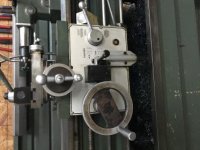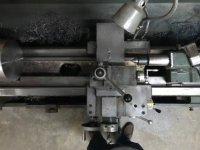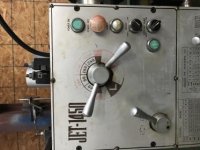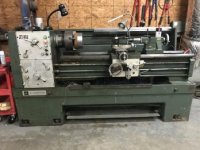Welcome to our forum. Be forewarned that the type of lathe you are inquiring about may be on the "forbidden list" of machinery for this 'board and the moderator may lock this thread.
We are always glad to learn of another person wanting to learn about machine work, and self-teaching is a tall order. With today's internet and youtubes, along with indexable carbide cutting tools, it is a much easier matter than when many of us came into this work. We are always happy to provide what information and help we can, though be forewarned that some of us have some interesting senses of humor, some interesting ways of expressing ourselves, and can be brutally frank.
That being said, to address your inquiry:
You have what I would call a "generic" engine lathe. It is of a type made by a number of manufacturers in Taiwan and China. In general, the machine tools built in Taiwan were a bit better quality than the same machine tools built in China. "Jet" was never an original manufacturer, but a "brand name", a company which had the machine tools built to their specs by a variety of manufacturers. In general, the "Jet" name was a bit better than the usual run of Chinese made machine tools.
If your lathe is complete, undamaged, and fully operational, you are ahead of the game. You are in a situation similar to a great many of us who acquire old machine tools. We often have machine tools for which there is little or no information and definitely no replacement parts and manuals and "how to operate and maintain" type information is nonexistant.
When I was a high school student (1964-68), I attended Brooklyn Technical HS. I had 3 years of machine shop classes. We were turned loose on a wide variety of machine tools, some being line-shaft driven (overhead lineshafting and belts to each machine tool). Some were geared-head lathes and mills from the '30's-60's. No safe guards, emergency stop switches or guards on many of those machine tools. We had only minor injuries, an occasional cut, bruise or similar. Our teachers came "out of industry", and they taught us kids to do a number of things when going to operate machine tools. The first thing was to use our eyes and heads. We had NO manuals on any of those machine tools. We were taught to figure out the controls and methods of operation by "pulling a machine through" (pulling the belt or rolling the spindle over by hand) to determine what the various controls or levers did. By pulling a machine tool through using hand power, there was no danger of damaging its working parts. We learned which levers engaged the various power feeds, reversed them, engaged the half nuts, and how the clutch/brake worked on each machine tool. Different manufacturers of lathes had different designs, and we had: geared head Hendey lathes; geared head Bradford lathes; geared head Lodge and Shipley lathes; newer geared head LeBlond Regal lathes; along with shapers, horizontal mills, surface grinders, drills including radial drills of different makers, and much more. By taking time to work the controls while turning the spindle by hand, and looking at which lever was situated next to some other component and its location, we were able to figure out how to operate otherwise new machine tools we had never run before. We were also taught, particularly on lathes, to setup our jobs and "pull the spindle over by hand" with the carriage and compound/toolpost as close up to the work as the job was going to require during machining. This prevented "crashes" (running the carriage and compound/toolpost/toolholder into a revolving piece of work on a faceplate, or into the jaws of a chuck).
I tell people the biggest part of any machine work is "head work"- using your mind to figure things out. Make sketches of your work, determine setups, sequence of cuts, tools to be used, etc before you go near the actual work or the lathe. The name of the game in setting up work and cutting tools on any machine tool (at least in my own book) is rigidity. Keep the amount that tools overhang the compound to a minimum, and keep the amount the compound overhangs or extends beyond its base of a minimum.
Check the lathe for proper lubrication before you start using it. It is a geared-head machine tool, so the headstock will need to be filled to correct level with correct lubricant. There may be some sight glass ("bullseye") on the headstock, or there may be a "fill line" somewhere on the headstock, maybe inside the belt guard to the extreme left end of the lathe as you face it. There may be lubrication instructions inside the belt guard as well on a data plate. The apron of the lathe will also need to be filled to correct level with lubrication. Without knowing the specifics for your lathe, a good choice of lubricant would be an ISO 46 DTE series oil. This is a straight-weight, mineral based oil with anti-corrosion and anti-foam additives. DTE = "dynamo, turbine, engine" and is an old designation of oils predating the automobile and still used in the powerplant and manufacturing sectors. You can obtain ISO 46 DTE oil as "tractor hydraulic oil", in two-gallon jugs if you have a Tractor Supply or similar near you. The carriage/apron might take a "Waylube"- an oil with "tackifiers" to make it "sticky", adhering to sliding surfaces like the bedways and dovetail slides of the lathe. Make sure you check lubrication before you start that lathe under power to do any kind of work with it.
Another good habit: Roll the spindle by hand when changing spindle speeds and make sure the gears (or jaw clutches) in the headstock are fully engaged. The speed selector levers may have "detents" (spring loaded ball bearings) to hold them in position, and these may be light in terms of latching ability. If you do not have the headstock gears fully engaged when you change speeds, under load, they can hop out of engagement with a hell of a noise and potential for heavy damage. NEVER change headstock (spindle) speeds with the gearing turning under power. Feed/thread gearing can usually be shifted under power with the spindle turning at very low speeds.
Getting feed/threading change gearing engaged can take some doing, and running the spindle at low speed or "jogging" (bumping the start switch so the spindle turns for a few seconds and coasts down) and gently moving the selector will help with engaging the threading/feed gearing.
Not much else to add at this point. Just be careful, do not get complacent or take any chances as this is a machine tool that does not care whether it cuts steel or you and can wind you up into the work in a heartbeat. If you go to change chucks, place some wood blocking on the bedways to support the chuck. It saves your fingers and your back and protects the bedways. Wear eye protection anytime you are running the lathe, keep your sleeves rolled up and avoid loose clothing that could get wound up in the chuck or work. Remove rings and jewelry before using the lathe. Make sure you have good light, and do your headwork before you get to doing anything around the lathe and you should be OK.
 9B7AA4C3-CB89-416E-9552-CEA2846C7A87.jpg19.1 KB · Views: 163
9B7AA4C3-CB89-416E-9552-CEA2846C7A87.jpg19.1 KB · Views: 163 BB4D5C38-8781-4EE9-AB48-BD80293BECB6.jpg17.6 KB · Views: 169
BB4D5C38-8781-4EE9-AB48-BD80293BECB6.jpg17.6 KB · Views: 169 60B5580C-6B12-4E07-ACD1-B666E069734B.jpg18 KB · Views: 165
60B5580C-6B12-4E07-ACD1-B666E069734B.jpg18 KB · Views: 165 6CE53374-D530-46EE-8777-AB9B9B76D811.jpg19.3 KB · Views: 163
6CE53374-D530-46EE-8777-AB9B9B76D811.jpg19.3 KB · Views: 163 899E9EF9-ECCC-4855-9540-C3948BF38A5D.jpg20.1 KB · Views: 367
899E9EF9-ECCC-4855-9540-C3948BF38A5D.jpg20.1 KB · Views: 367

